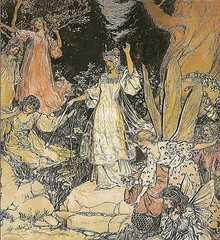3. Which Nobel Prize-winning English author is best remembered for the novel "The Lord of the Flies", a title which is, in itself, an allusion to the Devil?
From Quiz Who the Devil Wrote It?
Answer:
William Golding
Written by William Golding, "Lord of the Flies" is a dystopian novel which centres on a group of young English boys, who find themselves stranded on an uninhabited island. Published in 1954, "Lord of the Flies" is Golding's first novel, and has much to say about humanity's struggle with good and evil.
The island itself can be seen as a metaphor for the Garden of Eden, especially in the early chapters, in which the island is largely described as a paradise, with its very own "lagoon", and a shore that is "fledged with palm trees". However as with its biblical counterpart, evil also invades this paradise and this directly coincides with the boys' arrival. Indeed their arrival on the island, which is due to a plane crash, tarnishes it forever, leaving a "long scar smashed into the jungle", which is a permanent reminder of man's capacity for spreading evil, a theme that runs throughout the entire novel.
In this particular novel the figure of the Devil is wholly metaphorical, with multiple characters succumbing to his influence. Yet there is no doubting the fact that the Devil is present, and we need only look to the title of Golding's novel for proof of this. The Devil has many names, one of which is Beelzebub, and the novel's title, "Lord of the Flies", is a literal translation of this name. Lord of the Flies, along with numerous other terms, is therefore a synonym for Satan, the Devil himself. As anyone who has read the novel knows, the influence of the Lord of the Flies runs through the novel, and is instrumental in the deaths of Simon and Piggy, as well as the corruption of the rest of the boys. Many also argue that it is the force that allows Roger to reveal his true self, so that he goes from being "a slight furtive boy whom no one knew", to one who wants to harm others in the middle of the novel, only to be restrained by the "invisible yet strong" taboo "of the old life". However by the final chapters of "Lord of the Flies", Roger has revealed his inner devil, and the torturer within, who launches the boulder that kills Piggy, and hunts for Ralph with a stick that has been sharpened "at both ends".
 Magic has many definitions. Some refer to tricks performed onstage, but in a different vein, magic can refer to any seemingly impossible or extraordinary condition, quality or power. Can you divine the answers to these ten questions?
Magic has many definitions. Some refer to tricks performed onstage, but in a different vein, magic can refer to any seemingly impossible or extraordinary condition, quality or power. Can you divine the answers to these ten questions? 






 = Top 5% Rated Quiz,
= Top 5% Rated Quiz,